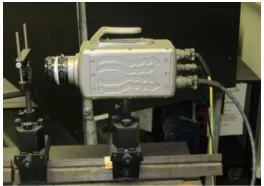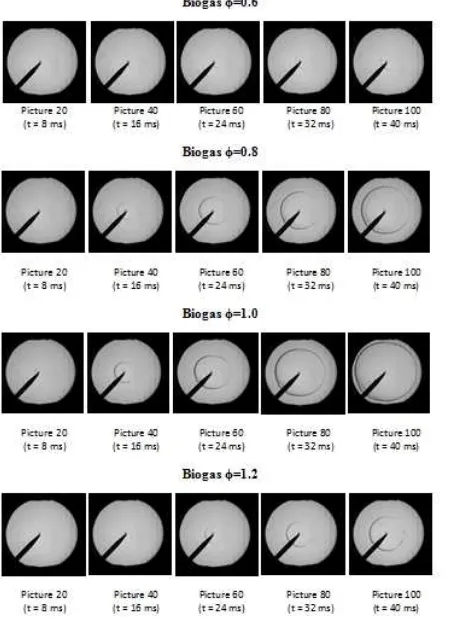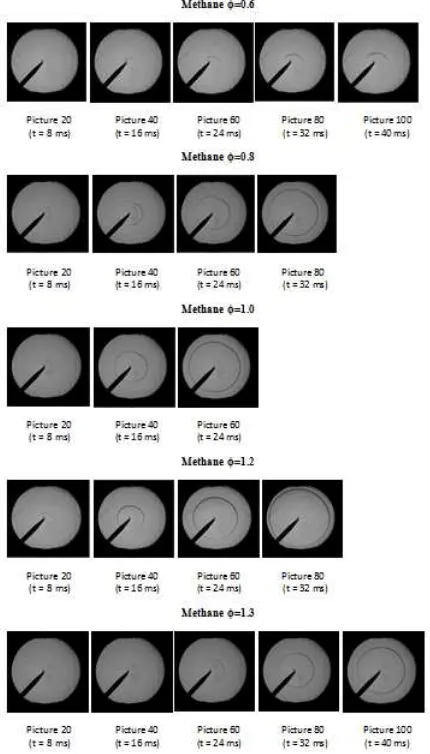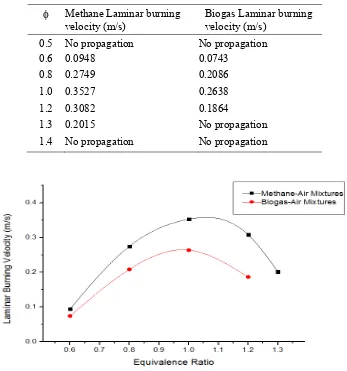Biogas Laminar Burning Velocity and Flammability Characteristics in Spark Ignited Premix
Combustion
This article has been downloaded from IOPscience. Please scroll down to see the full text article.
2013 J. Phys.: Conf. Ser. 423 012015
(http://iopscience.iop.org/1742-6596/423/1/012015)
Download details:
IP Address: 203.189.120.18
The article was downloaded on 12/04/2013 at 02:25
Please note that terms and conditions apply.
Biogas Laminar Burning Velocity and Flammability
Characteristics in Spark Ignited Premix Combustion
Willyanto Anggono1, ING Wardana2, M. Lawes3, K. J. Hughes4, Slamet Wahyudi5, Nurkholis Hamidi6, Akihiro Hayakawa7
1
Petra Christian University/ Mechanical Engineering Department, Surabaya, Indonesia.
1,2,5,6
Brawijaya University/ Doctoral Program Mechanical Engineering Department, Malang, Indonesia.
1,4
The University of Leeds/ School of Process, Environmental and Materials Engineering, Leeds, England.
3
The University of Leeds/ School of Mechanical Engineering, Leeds, England.
7
Kyushu University/Department of Mechanical Engineering, Fukuoka, Japan.
E-mail: [email protected]
Abstract. Spherically expanding flames propagating at constant pressure were employed to determine the laminar burning velocity and flammability characteristics of biogas-air mixtures in premixed combustion to uncover the fundamental flame propagation characteristics of a new alternative and renewable fuel. The results are compared with those from a methane-air flame. Biogas is a sustainable and renewable fuel that is produced in digestion facilities. The composition of biogas discussed in this paper consists of 66.4% methane, 30.6% carbon dioxide and 3% nitrogen. Burning velocity was measured at various equivalence ratios (ϕ) using a photographic technique in a high pressure fan-stirred bomb, the initial condition being at room temperature and atmospheric pressure. The flame for methane–air mixtures propagates
from ϕ=0.6 till ϕ=1.3. The flame at ϕ≥1.4 does not propagate because the combustion reaction is quenched by the larger mass of fuel. At ϕ≤0.5, it does not propagate as well since the heat of
reaction is insufficient to burn the mixtures. The flame for biogas–air mixtures propagates in a
narrower range, that is from ϕ=0.6 to ϕ=1.2. Different from the methane flame, the biogas flame does not propagate at ϕ≥1.3 because the heat absorbed by inhibitors strengthens the quenching effect by the larger mass of fuel. As in the methane flame, the biogas flame at ϕ≤0.5 does not propagate. This shows that the effect of inhibitors in extremely lean mixtures is small. Compared to a methane-air mixture, the flammability characteristic (flammable region) of biogas becomes narrower in the presence of inhibitors (carbon dioxide and nitrogen) and the presence of inhibitors causes a reduction in the laminar burning velocity. The inhibitor gases work more effectively at rich mixtures because the rich biogas-air mixtures have a higher fraction of carbon dioxide and nitrogen components compared to the lean biogas-air mixtures.
1. Introduction
Biogas as “Powergas” is an alternative fuel, it is a sustainable and renewable fuel that is produced in digestion facilities. It does not contribute to the increase in atmospheric carbon dioxide concentrations because it comes from an organic source with a short carbon cycle and is thus a green solution in the development of sustainable fuels [1,2]. The digestion facilities can be constructed quickly in a few days using unskilled labor [3]. Biogas contains 50–70% methane and 30–50% carbon dioxide, as well
ScieTech 2013 IOP Publishing
as small amounts of other gases and typically has a calorific value of 21–24 MJ/m3
[4]. Based on chemical analysis, the composition of the biogas produced in East Java, Indonesia is 66.4% methane, 30.6% carbon dioxide and 3% nitrogen [1,2]. Methane is a flammable gas, whereas, nitrogen and carbon dioxide are inhibitors [5]. The Kyoto protocol was intended to reduce greenhouse gas emissions, and to further this objective, research into biogas combustion in stoves, engines and gas turbines has had good results [4,6-10]. However, the laminar burning velocity and flammability characteristic of biogas, being a fundamental characteristic of a fuel, have not been studied yet. Thus, the aim of this paper was to investigate its laminar burning and flammability characteristics.
Demands for replacing fossil fuels to reduce emissions, require an improved fundamental understanding of the combustion processes that occur within the internal combustion engine. An important characteristic is the burning velocity, which directly affects pressure development and is often expressed in terms of laminar burning velocity [1,2,11-16].
Flammability limits, give the proportion of combustible gases in a mixture, between which limits this mixture is flammable. Gas mixtures consisting of combustible, oxidizing, and inert gases are only flammable under certain conditions. The lower flammable limit describes the leanest mixture that still sustains a flame, i.e. the mixture with the smallest fraction of combustible gas, while the upper flammable limit gives the richest flammable mixture. The laminar burning velocity and flammability are the most important flame propagation characteristics in spark ignited premixed combustion and as the fundamental flame propagation characteristic of biogas require further study; this paper looks into this matter with view to a better understanding of a new alternative and renewable fuel. The results are compared with those from methane-air flames to emphasize the contrast between the burning velocity and flammability characteristics of methane-air mixtures and biogas-air mixtures.
2. Experimental Methods
The laminar burning velocity of biogas premixed combustion was measured in the Mk II high pressure fan-stirred combustion vessel at the Leeds University School of Mechanical Engineering as shown in Fig. 1. Initially, all the experiments in this paper were performed at room temperature, at atmospheric pressure and with mixtures of various equivalence ratios (ϕ= 0.5, 0.6, 0.8, 1.0, 1.2, 1.3). The bomb is a spherical stainless steel vessel of 380 mm diameter, with three pairs of orthogonal windows each of 150 mm diameter and equipped with four electrically driven fans to ensure good mixing [1,2,11-14]. The fuel-air mixtures in the Mk II combustion bomb were centrally ignited and flame propagation was recorded by high speed schlieren cine-photography using a Photosonics Phantom digital camera as shown in Fig. 2, operating at a rate of 2500 frames/s with a resolution of 768 x 768. The flame radius was calculated as that of a circle encompassing the same area as that enclosed by the schlieren imaged flame [1,2,11-14].
Figure 1. Mk2 Combustion Bomb. Figure 2. High Speed Schlieren Cine-Photography
The laminar burning velocity for a spherically expanding flame can be deduced from the schlieren photographs, the stretched flame velocity (Sn) can be derived from the flame radius versus time data
as: Sn = dru/dt, where ru is the flame radius in the Schlieren photographs and t is the elapsed time from
the spark ignition. The flame stretch rate α is defined as α = d(ln A)/dt = (dA)/(A dt), where A is the
ScieTech 2013 IOP Publishing
Journal of Physics: Conference Series423(2013) 012015 doi:10.1088/1742-6596/423/1/012015
area of the flame. In the case of a spherically propagating premixed flame, the flame stretch rate can be calculated by α =(2/ru)(dru/dt). A linear relationship between flame speed and the total stretch
exists, and this is quantified by burned gas of Markstein length, Lb, and is defined at the radius, ru,
such that: Sn–Ss = Lbα, where Ss is the unstretched flame speed, and is obtained as an intercept value
of Snat α = 0 in the plot of Sn against α. The gradient of the best straight line fit to the experimental
data gives Lb. The unstretched laminar burning velocity, ul, was deduced from Ss using ul = Ss(ρb/ρu),
where ρbis the density of the burned gas mixtures and ρu is the density of the unburned gas mixtures
[1,2,11-14].
3. Results and Discussion
Based on the experimental investigation, the biogas-air mixtures at the intermediate equivalence ratios (ϕ=0.6, 0.8, 1.0, 1.2) were observed to produce a propagating flame, whereas at the extreme equivalence ratios (ϕ=0.5 and 1.3) no propagating flames were observed. The images resulting from the spherical flame propagation within the combustion bomb are shown in Fig. 3.
Figure 3. Flame Propagation Biogas-Air Mixtures at Various Equivalence Ratios.
The radius of the spherical flame propagation in Fig. 3 are presented in Fig. 4 as a function of elapsed time. Based on experiment results and the calculations as mentioned in the experimental method and previous studies [1,2,13], the laminar burning velocities of biogas-air mixtures in premixed combustion are 0.0743 m/s for lean (ϕ=0.6), 0.2086 m/s for lean (ϕ=0.8), 0.2638 m/s for stoichiometric (ϕ=1.0) and 0.1864 m/s for rich (ϕ=1.2) biogas-air mixtures, which are in agreement with previous studies [1,2].
ScieTech 2013 IOP Publishing
Figure 4. Flame Radius vs Elapsed Time of Biogas-Air Mixtures at Various Equivalence Ratios
For comparison, the laminar flame propagation of methane is also presented as shown in Fig. 5. The methane-air mixtures equivalence ratio (ϕ=0.6, 0.8, 1.0, 1.2, 1.3) were found to have produced a propagating flame, whereas for the extreme equivalence ratio (ϕ=0.5 and 1.4) no propagating flames were observed.
Figure 5. Flame Propagation Methane-Air Mixtures at Various Equivalence Ratios
ScieTech 2013 IOP Publishing
Journal of Physics: Conference Series423(2013) 012015 doi:10.1088/1742-6596/423/1/012015
Based on the experimental results and the same calculations and method for the laminar burning velocity of the various equivalence ratios of biogas-air mixtures, the laminar burning velocities of the methane-air mixtures were found. The laminar burning velocities were 0.0948 m/s for lean (ϕ=0.6), 0.2749 m/s for lean (ϕ=0.8), 0.3527 m/s for stochiometic (ϕ=1.0), 0.3082 m/s for rich (ϕ=1.2) and 0.2015 m/s for rich (ϕ=1.3) methane-air mixtures, which were in agreement with previous studies [1,2,13]. A summary of the results from biogas and methane are shown in Table 1 and Fig. 6.
Table 1. Laminar Burning Velocities of Methane and Biogas Methane Laminar burning
velocity (m/s)
Biogas Laminar burning velocity (m/s)
0.5 No propagation No propagation
0.6 0.0948 0.0743
0.8 0.2749 0.2086
1.0 0.3527 0.2638
1.2 0.3082 0.1864
1.3 0.2015 No propagation
1.4 No propagation No propagation
Figure 6. Laminar Burning Velocities of Methane-Air Mixtures and Biogas-Air Mixtures
From Table 1 and Fig. 6, it can be seen that laminar burning velocities of stoichiometric (ϕ=1) biogas-air mixtures and methane-air mixtures are higher than the lean and rich mixtures because the stoichiometric mixtures have just enough air for complete combustion of the available fuel [1,2]. As expected, because of the presence of carbon dioxide and nitrogen in the biogas, at the same equivalence ratio, the laminar burning velocity of biogas-air mixtures were lower than the laminar burning velocitiy of the methane-air mixtures. The carbon dioxide and nitrogen in the biogas are inhibitors that tended to decrease the laminar burning velocities [1,2,5,17].
The flames for the methane–air mixtures propagated from ϕ=0.6 till ϕ=1.3. But at ϕ≥1.4 the flame did not propagate because the combustion reaction was quenched by the larger mass of fuel. At ϕ≤0.5, the flame did not propagate either since reaction heat was insufficient to burn the mixtures. Flames for biogas–air mixtures propagated at narrower range, i.e. ϕ=0.6 to ϕ=1.2. In contrast, the biogas flame did
ScieTech 2013 IOP Publishing
not propagate at ϕ≥1.3. This was due to the fact that the inhibitors in the fuel absorbed some of the heat from the combustion reaction. Therefore, the quenching effect in the larger mass of fuel was stronger. At ϕ≤0.5, the same as in methane flame, the biogas flame did not propagate. This shows that the effect of inhibitors was very small at extreme lean mixtures. Compared to a methane-air mixture, the flammable region of biogas became narrower in the presence of inhibitors (carbon dioxide and nitrogen) and the presence of inhibitors caused a reduction in the laminar burning velocity for two reasons. Firstly, the dilution effect lead to a lower concentration of reactive species in the fuel-air mixture for a given equivalence ratio, which lead to a lower overall chemical reaction rate of bimolecular reactions in the fuel oxidation reaction process. Secondly, the presence of these inhibitor gases absorbed some of the heat generated, thus lowering the flame temperature which in turn will tend to reduce the overall rate of many of the chemical reactions within the fuel oxidation process. The inhibitor gases were more effective in rich mixtures because the rich biogas-air mixtures had a higher fraction of carbon dioxide and nitrogen components compared to lean biogas-air mixtures.
4. Conclusion
The flames for the methane–air mixtures from ϕ=0.6 till ϕ=1.3 propagated, whereas, the flames in mixtures of ϕ≥1.4 did not propagate because the combustion reaction was quenched by the larger mass of fuel. The methane flame at equivalence ratio of ϕ≤0.5 did not propagate either. This was due to the fact that the reaction heat was insufficient to burn the mixtures. The flames for biogas–air mixtures were propagated at narrower ranges, that is from ϕ=0.6 to ϕ=1.2. The biogas flame did not propagate for ϕ≥1.3 because the inhibitors in the mixture absorbed some of the heat from the combustion reaction so that the quenching effect in the larger mass of fuel was stronger. As for the methane flame, biogas flame at ϕ≤0.5 did not propagate which shows that the inhibitor effect was small in the lean mixtures. The laminar burning velocities of the biogas-air mixtures in the premix combustion were 0.0743 m/s for ϕ=0.6, 0.2086 m/s for ϕ=0.8, 0.2638 m/s for ϕ=1.0 and 0.1864 m/s for ϕ=1.2 biogas-air mixtures respectively. The inhibitor gases were more effective at rich mixtures because the rich biogas-air mixture had a higher fraction of the carbon dioxide and nitrogen components compared to the lean biogas-air mixtures. The flammability characteristic (flammable region) of biogas became narrower in the presence of inhibitors (carbon dioxide and nitrogen) and the presence of the inhibitors caused a reduction in the laminar burning velocity
Acknowledgments
Many Thanks to Direktorat Jendral Pendidikan Tinggi Kementrian Pendidikan Nasional Republik Indonesia, Universitas Brawijaya, Petra Christian University, Leeds University, Prof. M. Pourkashanian (Leeds University), Professor Derek Bradley (Leeds University), Professor Mike Pilling (Leeds University), and Bambang Pudjianto (BBA Gas) for their support during this research.
References
[1] Anggono. W., Wardana. I.N.G., Pourkashanian. M., Hughes. K.J., Lawes. M.,Wahyudi. S., Hamidi. N., and Hayakawa. A., 2012. Experimental and Numerical Simulation on Boigas Flame Propagation Characteristic in Spark Ignition Premixed Combustion, Proceeding The3rd International Conference on Engineering and ICT (ICEI2012) Melaka-Malaysia, Vol. 2, pp. 290-294.
[2] Anggono. W., Wardana. I.N.G., Lawes. M., Hughes. K.J., Wahyudi. S., Hamidi. N., 2012. Laminar Burning Characteristics of Biogas-Air Mixtures in Spark Ignited Premix Combustion. Journal of Applied Sciences Research.
[3] Lichtman. R., et. al., 1996. The Improved Biogas Systems Project: results and future work, Energy for Sustainable Development, Volume 3, Issue 4, pp. 28–42.
[4] Bond. T., and Templeton. M.R., 2011. History and future of domestic biogas plants in the developing world., International Journal Energy for Sustainable Development Volume 15, Issue 4, pp. 347–354.
ScieTech 2013 IOP Publishing
Journal of Physics: Conference Series423(2013) 012015 doi:10.1088/1742-6596/423/1/012015
[5] Ilminnafik. N., Hamidi. N., and Wardana. I.N.G., 2011, Behavior of flame propagation in LPG premixed combustion with carbon dioxide inhibitor, International Journal of academic research. Vol. 3. No. 2. March, 2011, Part III, pp. 705-708.
[6] Alwis. A.D., 2002. Biogas-A review of Sri Lanka's performance with a renewable energy technology, Energy for Sustainable Development, Volume 6, Issue 1, March 2002, Pp. 30– 37.
[7] Lafay. Y., Taupin .B., Martins .G., Cabot .G., Renou .B., and Boukhalfa, 2007. Experiment study of biogas combustion using a gas turbine configuration. Experiments in Fluids: Springer 43, pp. 395-410.
[8] Nathan. S.S.,Mallikarjuna. J.M., and Ramesh. A., 2010. An experimental study of the biogas– diesel HCCI mode of engine operation, Energy Conversion and Management 51, pp. 1347– 1353.
[9] Porpatham. E.,Ramesh. A., and Nagalingam. B., 2008. Investigation on the effect of concentration of methane in biogas when used as a fuel for a spark ignition engine, Fuel 87, pp.1651-1659.
[10] Sridhar G., Paul P.J. and Mukunda H.S. 2001. Biomass Derived Producer Gas as a Reciprocating Engine Fuel – An Experimental Analysis, Biomass & Bioenergy, Vol. 21, pp. 61-72.
[11] Bradley. D., Hicks. R.A., Lawes. M., Sheppard. C.G.W. and Wooley, R, 1998. The measurement of laminar burning velocities and Markstein numbers for isooctane-air and iso-octane-n-heptane-air mixtures at elevated temperatures and pressures in an explosion bomb, Combustion and Flame 115, pp. 126-144.
[12] Gillespie. L., Lawes. M., Sheppard. C.G.W., and Woolley. R., 2000. Aspects of laminar and turbulent burning velocity relevant to SI engines. SAE Paper Series 2000-01-0192.
[13] Gu. X.J., Haq. M.Z., Lawes. M., and Wooley. R., 2000. Laminar burning velocity and Markstein lengths of methane-air mixtures, Combustion and Flame 121, pp. 41-58.
[14] Serrano. C., Hernandez. J.J., Mandilas. C., Sheppard. C.G.W., and Woolley. R., 2008. Laminar burning behaviour of biomass gasification-derived producer gas, International Journal of Hydrogen Energy 33, pp. 851 – 862.
[15] Hermanns. R.T.E., 2007. Laminar Burning Velocities of Methane-Hydrogen-Air Mixtures, Doctoral Thesis Technische Universiteit Eindhoven, The Netherlands.
[16] Marshall. S.P., Taylor. S., Stone. C.R., Davies. T.J., and Cracknell. R.F., 2011. Laminar burning velocity measurements of liquid fuels at elevated pressures and temperatures with combustion residuals, Combustion and Flame 158, pp. 1920–1932.
[17] Ronney, P. D., 2001. Premixed-Gas Flames in Microgravity Combustion: Fires inFree Fall (H. Ross, Ed.), Academic Press, London, U.K.,pp. 35-82.
ScieTech 2013 IOP Publishing



